Barnacles are very common on crabs. But if you ask whether barnacles hurt crabs, then it depends on the type of barnacles and sometimes the crab’s species.
And in this article, I will provide detailed information on which barnacles harm crabs, how they do it, and why. Additionally, I will explain how to remove these harmful barnacles. So, continue reading for more.
Barnacles On Crab Legs
Barnacles on crab legs can be of two types – parasitic and non-parasitic.
Parasitic barnacles, like Sacculina carcini, are known to attach themselves to the crab’s legs or carapace and draw sustenance from the crab’s blood. This long-term blood loss can cause the crab to become weakened over time.
In extreme cases, the parasitic barnacles can even cause sterility in the host crab by altering its hormonal balance.
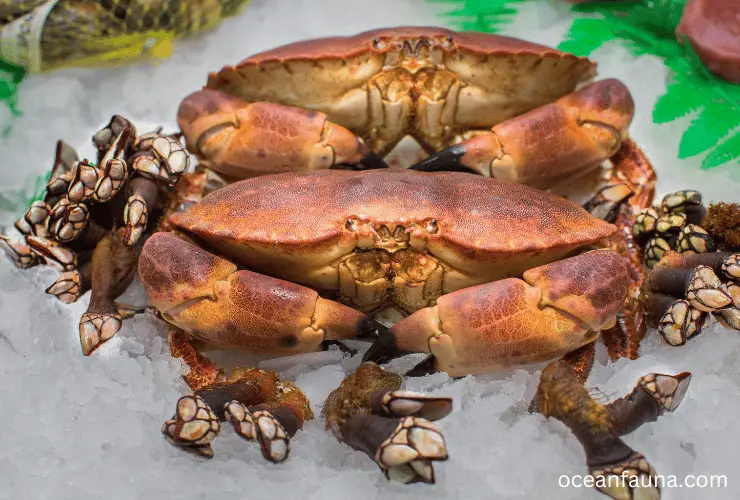
Non-parasitic barnacles, on the other hand, are not known to cause any harm to the host crab. These barnacles, like Acorn Barnacles, simply attach themselves to the hard exoskeleton of the crab and use it as a surface to build their own protective shell.
Barnacles on crab legs are a unique example of symbiosis in the marine ecosystem. The parasitic barnacles draw sustenance from the crab’s blood while providing no apparent benefit to the host. However, for non-parasitic barnacles, the crab’s hard exoskeleton is a surface to build their own protective shell, helping them safely navigate the turbulent ocean waves.
It is common to find parasitic barnacles in estuarine waters, near shoreline habitats, and sometimes even in deeper waters. The prevalence of parasitic barnacles in certain habitats can also serve as an indicator of the ecosystem’s overall health.
For example, the proliferation of parasitic barnacles in certain estuarine waters might suggest an imbalance in the food chain, where the crab population has grown too large, and the parasitic barnacles serve to regulate it.
Which Crabs Are Mostly Used as Hosts for Parasitic Barnacles?
Crabs are commonly known for their hard outer shells and tasty meat. However, they are also hosts for many parasitic organisms, including barnacles. Among the different types of crabs, green crabs and hermit crabs are commonly used as hosts for parasitic barnacles.
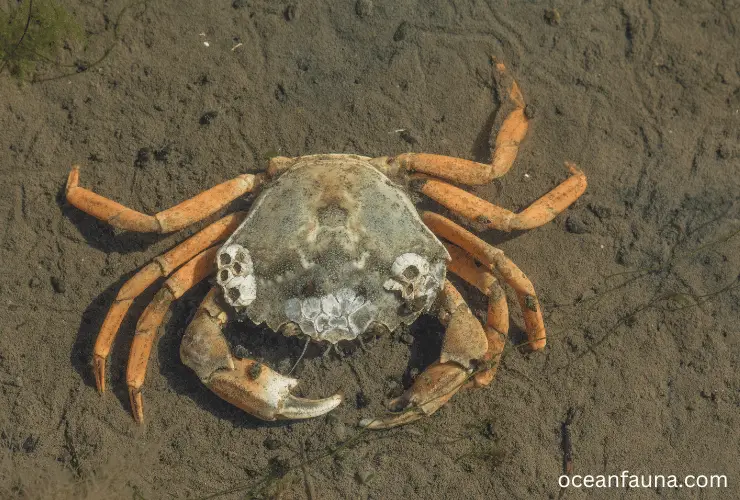
Green Crab
The green crab, which is native to the coasts of Western Europe and North Africa, is a common host for the parasitic barnacle Sacculina carcini. Sacculina carcini is a species of barnacle that predominantly infects the green crab. The female Sacculina carcini attaches itself to the underside of the crab’s body and sends a root-like structure into the crab’s body.
The parasite controls the crab’s behaviour, castrating it and converting it into a living incubator for the parasite. The crab’s behaviour is modified to protect the parasitic sac, which grows and releases spores that infect other crabs.
Hermit Crab
Clistosaccus paguri is a species of barnacle that is primarily parasitic on hermit crabs. Hermit crabs are a type of crab that use the empty remains of other animals as their shell.
Clistosaccus paguri attaches to the hermit crab’s shell, and its elongated, cone-shaped body rests in the aperture of the shell. The barnacle feeds off the hermit crab’s food and waste and may cause damage to the crab’s soft tissues.
Other types of crabs
Apart from green and hermit crabs, other types of crabs are also known to host parasitic barnacles. For instance, the ghost crab (Ocypode ceratophthalmus) and the fiddler crab (Uca pugnax) are known to host Sacculina carcini. However, the prevalence of parasite infestation in these crabs is not as high as in green and hermit crabs.
What Causes Barnacles on Crabs?
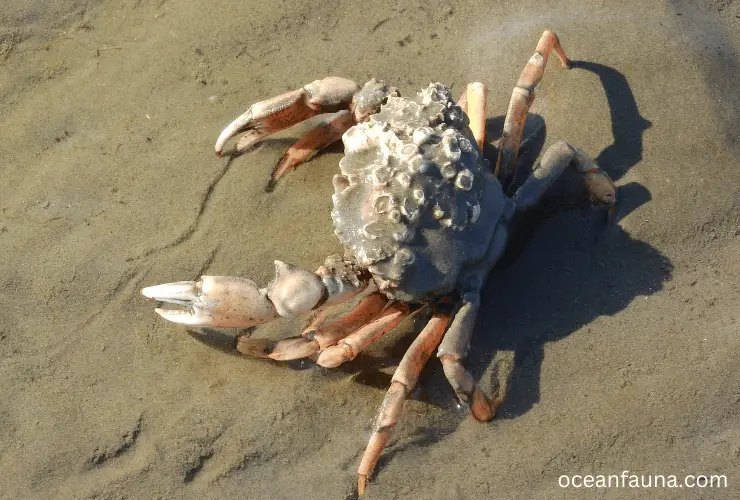
You already know barnacles are crustaceans that attach themselves to hard surfaces, including other animals like crabs. Two types of barnacles can be found on crabs – parasitic and non-parasitic. The causes of these two types of barnacles on crabs are explained in detail as follows:
Parasitic Barnacles
Parasitic barnacles are those that feed on the living tissue of the host crab and cause harm to it. The main causes of parasitic barnacles on crabs are as follows:
Infected Water
Parasitic barnacles can infect the water where the crabs live. When the crabs come into contact with the water, they become infected. This can happen when the crabs are in an environment with a high density of parasitic barnacles.
Weakened Immune System
Crabs with weakened immune systems are more susceptible to parasitic barnacles. If a crab is already sick or if its immune system is compromised due to environmental factors, the likelihood of it getting parasitic barnacles increases.
Poor Hygiene
If a crab’s environment is not clean, it is more likely to become host to parasitic barnacles. Parasitic barnacles thrive in dirty water, and when the crabs are exposed to such an environment, they have an increased chance of becoming infected.
High Salinity
High salt in the water can also increase the risk of parasitic barnacle infection for crabs. A high salt concentration in the water can weaken the crab’s ability to fight off parasites and may lead to an increased likelihood of infection.
Host for Barnacles
In some cases, a crab can become host to barnacles even when other causes are not present. This can happen due to the presence of an existing population of barnacles in the environment or because certain crabs may be more appealing hosts for parasitic barnacles.
Non-Parasitic Barnacles
Non-parasitic barnacles do not feed on the living tissue of the host crab, but they do cause harm to the crab’s mobility and overall health. The main causes of non-parasitic barnacles on crabs are as follows:
Attachment to Hard Surfaces
Crabs are natural host surfaces for non-parasitic barnacles as they provide a hard surface for the barnacles to attach themselves. When the crabs are stationary for a long time, barnacles may attach to them.
Swimming in Infected Waters
If the water the crabs are swimming in is heavily infested with non-parasitic barnacles, then the likelihood of them attaching to the crab increases. This is because the barnacles are looking for a hard surface to attach themselves to, and the crab provides that surface.
Do Barnacles Hurt Crabs?
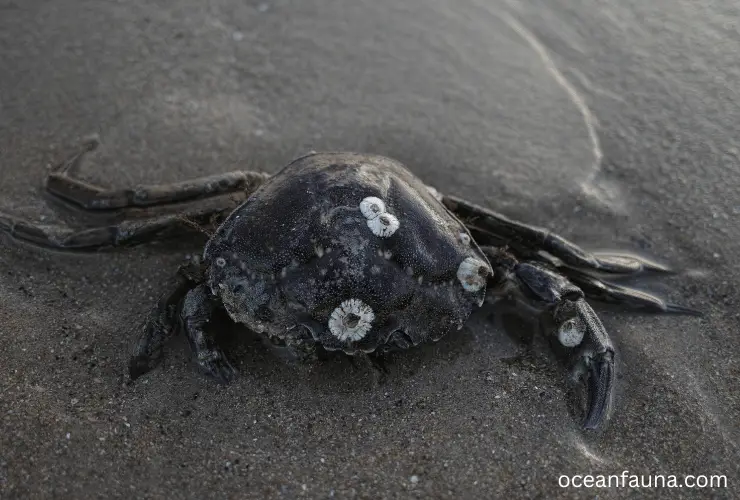
Yes, barnacles can hurt crabs. However, the degree of harm inflicted on the crab varies depending on whether the barnacle is parasitic or non-parasitic.
Parasitic barnacles are the most harmful to crabs. These barnacles attach themselves to the crab’s body and feed on its living tissue.
This persistent feeding can cause significant damage to the crab over time. In severe cases, parasitic barnacles can cause the crab to become immobilized, unable to move and fend for itself. This can lead to the crab’s demise as it becomes an easy target for predators.
Non-parasitic barnacles, on the other hand, are less harmful to crabs. These barnacles attach themselves to the crab’s shell or other hard surfaces, which can limit its mobility. While the attached barnacles may cause some irritation to the crab, they typically do not cause lasting damage to the crab’s body.
Remember, while non-parasitic barnacles may not cause significant harm to crabs, they can still impact the crab’s ability to survive. Barnacle buildup on a crab’s shell can increase its weight, making it harder for the crab to move and avoid predators.
Additionally, a heavy barnacle load can make it harder for the crab to moult, a process essential to its growth and survival.
Do Barnacles Hurt Hermit Crabs?
I would like to clarify that the type of barnacles present on a hermit crab’s shell can determine whether the crab gets injured or not.
Clistosaccus paguri is a parasitic barnacle that attaches itself to the hermit crabs. These barnacles affect hermit crabs’ behaviour and life cycle, often causing severe damage to their soft tissues. They attach themselves to the crab’s abdomen and start draining nutrients from the host while altering the hermit crab’s behaviour and physiology.
The parasitic barnacle, Clistosaccus pagri, is known to cause reproductive and behavioural changes in hermit crabs, which in turn impede their survival rate. The barnacle also affects the crab’s mobility, making it difficult for them to move freely and find new shells.
These consequences significantly affect the hermit crab’s health and make them vulnerable to further predation.
On the other hand, non-parasitic barnacles, such as Balanus improvisus, may also latch onto hermit crabs. But in this case, they do not harm the hosts. Instead, they might help provide a protective layer to the crab’s shell, allowing them to avoid predators.
The non-parasitic barnacles also provide a home for other small organisms, which might benefit the hermit crab by providing a food source.
Why Are Barnacles On Crabs Bad?
You might know barnacles are typically found on rocks, whales, and the bottom of boats. But they are also known to attach themselves to the exoskeleton of crabs. Though barnacles may look harmless to the naked eye, they can actually harm crabs in various ways. In this portion, I have explored the reasons why barnacles on crabs are bad.
Infertility
Parasitic barnacles, as mentioned earlier, grow through the body of the host crab and affect their reproductive system, rendering them infertile. This makes it difficult for crabs to reproduce and may lead to a decline in their species’ population.
Reduced Mobility
Non-parasitic barnacles, on the other hand, attach themselves to the exoskeleton of the crab, leading to reduced mobility. Barnacles that grow too large may drag down the crab, making it an easy target for predators. Reduced mobility can also harm crabs’ ability to find food, mate, and defend themselves.
Fungus and Bacteria Infections
Barnacle infestations also increase the chances of crab’s susceptibility to bacteria and fungus infections. As parasites grow on the surface of the crab, they create nicks and scratches, which offer an entry point for bacteria and fungi. The resulting infections can cause serious damage to the crab’s health.
Increased energy expenditure
With excess barnacle growth on their bodies, crabs have to exert more energy to move around and carry their shells, leaving them with less energy for other essential activities like foraging and avoiding predators.
Others
Barnacles can also cause a decrease in the crab’s carapace size, which is its hard outer shell that serves as protection. A decrease in carapace size leaves crabs more vulnerable to predation and bad weather conditions.
Barnacles On Horseshoe Crabs
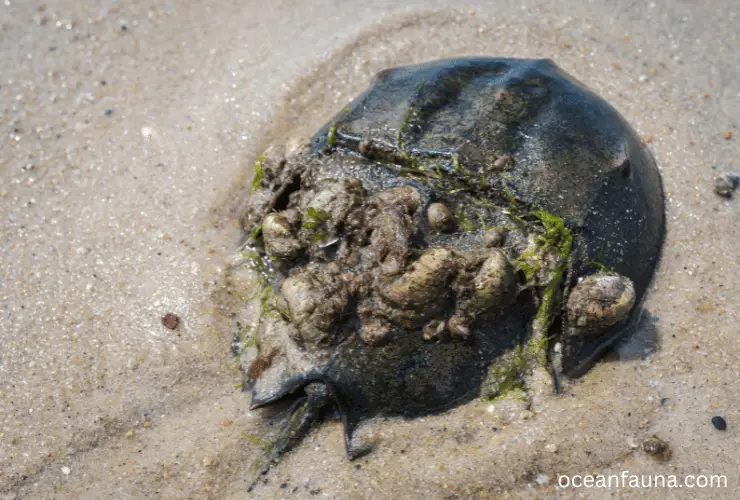
Barnacles are a type of marine crustacean that are known to attach themselves to the hard shells of various marine organisms like crabs, including horseshoe crabs. These small arthropods are filter feeders that rely on ocean currents to bring nutrients and small organisms to them, and they are not harmful to the horseshoe crab in any way.
In fact, scientists have found that barnacles may even provide some benefits to their horseshoe crab hosts.
One of the essential benefits of barnacles on a horseshoe crab is that they can help to camouflage the crab from predators. Horseshoe crabs are a favourite prey of many marine predators, including sharks and sea birds, and their hard shells can be easy to spot against a sandy or rocky ocean floor.
However, when barnacles attach to the outside of the shell, they can help to break up the crab’s outline and make it more difficult for predators to locate.
Barnacles may also provide a secondary benefit by helping to improve the horseshoe crab’s mobility. While horseshoe crabs are generally slow-moving creatures, barnacles can actually help to reduce drag and increase the crab’s speed and agility in the water.
This can be especially important during the spawning season when horseshoe crabs need to move quickly and efficiently to mate and lay their eggs.
Is It Safe to Eat Crabs with Barnacles On Them?
Based on the expert’s opinion, eating crabs with non-parasitic barnacles growing on the outside of their shells is generally safe. These barnacles do not typically affect the meat that is consumed from the inside of the crab. However, the situation may be different if the crab has parasitic barnacles.
Parasitic barnacles may remain in the crab’s body cavity and do not typically spread to the legs and other areas. Therefore, the crab’s meat is likely still safe to eat. However, it is important to note that if you open up the crab’s body cavity, you may see these parasitic barnacles, potentially affecting your appetite for the crab.
Overall, as long as the crab is cooked properly, it should be safe to consume. Before consuming any seafood, check for any visible signs of parasites or disease. If you are unsure of the quality or safety of the crab, it is always best to err on the side of caution and opt for a different meal.
How Do You Remove Barnacles from Crabs?
Traditionally, the standard method for removing barnacles from crabs was through manual removal using a knife or other scraping tool. However, as stated earlier, this method can be incredibly slow, labour-intensive, and expensive.
In recent years, alternative methods for removing barnacles from crabs have been developed. One such method involves using high-pressure water jets to blast off the barnacles from the crab’s shell. This method is more efficient than traditional manual removal, as it can remove multiple barnacles at once and is less invasive for the crab.
Another method is to use chemical solutions that dissolve the barnacles. These solutions contain enzymes or hydrochloric acid that break down the adhesive properties of the barnacles’ shells, causing them to fall off the crab naturally.
However, there are concerns about the potential impact of these chemicals on the crab’s health and the surrounding marine environment, so their use is not very common.
Additionally, preventive measures can be taken to reduce the likelihood of barnacle growth in the first place. These measures include keeping crabs in clean water, regularly inspecting them for any sign of barnacle growth, and using anti-barnacle coatings on the crab’s shells.
Conclusion
Now you have a compact knowledge of barnacles on crabs, including all the good and bad. But if you still have any queries regarding them, just let me know.


1 thought on “Barnacles On Crab: Do Barnacles Hurt Crabs?”